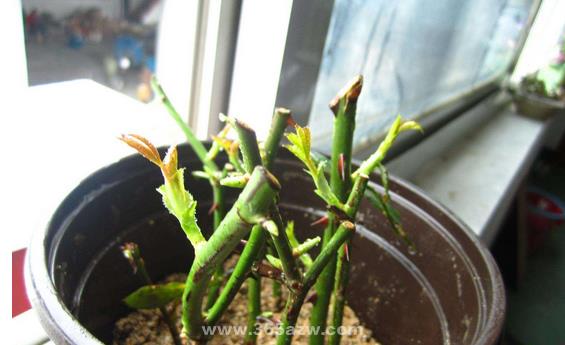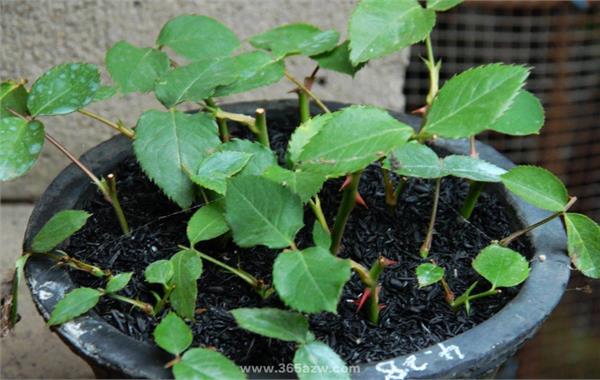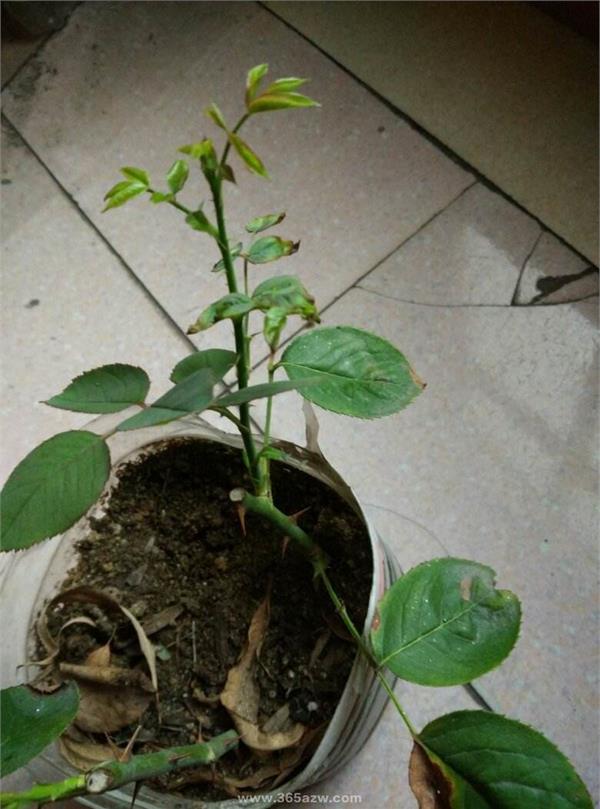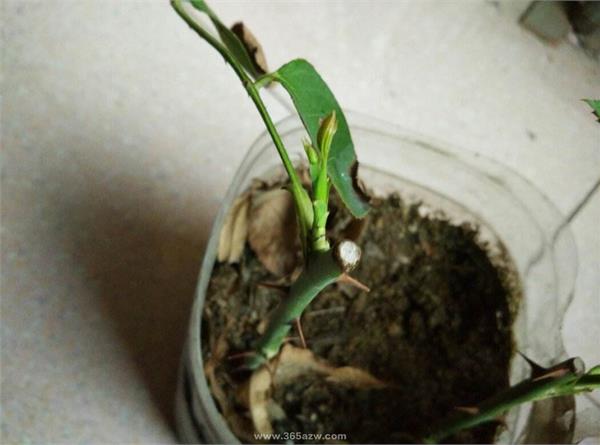Introduction to the insertion method and matters needing attention of Chinese rose
The best branches for roses are those in the early flowering stage. Let's take a look at the methods and points for attention of roses.

Introduction to the insertion method and matters needing attention of Chinese rose
In a group of experimental data of root growth rate, growth and survival rate of Chinese rose cuttings, it was found that the selection of rose cuttings at early flowering stage was beneficial to rooting, and the rooting effect of upper cuttings was better than that of middle and lower cuttings in the same period. But the Chinese rose cuttings with the highest survival rate are those in the middle flowering stage.
Some studies have shown that it is not easy to take root with hardwood cuttings of modern rose, but it is easier to take root after using tender twigs or semi-lignified branches, so the survival rate of flower cuttings is obviously higher than that of vegetative branches in the same variety and different branch type. this conclusion is applicable to modern rose. In the cuttings of different branches of the same variety, the middle cuttings accumulated more organic nutrients and the tissue maturity was moderate, so the middle branches were easy to survive.

At the same time, the cuttings with leaves are beneficial to rooting (only the top 1-2 leaves are retained). Although the leaves need to consume some nutrients, they can synthesize organic matter through photosynthesis to provide nutrients for cuttings. The phenomenon of fake living often occurs in the process of rose insertion. That is, after 5-10 days of insertion in the current month, the axillary buds on the cuttings have germinated or sprouted leaves, and they look alive, but soon wilt and die. To prevent the emergence of false living phenomenon, first of all, we can not choose the branches that already have budding buds as cuttings, but choose branches with high maturity, full axillary buds and ungerminated branches as cuttings (if there is an urgent need to use the branches that have germinated axillary buds as cuttings, and when the length is more than that, the germinating section can be cut off and reused. If it is a short branch, the germinated axillary buds can be removed with a sharp knife or completely removed to inhibit their development and let the lower axillary buds sprout. In this way, it can be rooting first, and then sprouting leaves); secondly, in order to make the cuttings root and then send leaves, it is necessary to make the temperature of the medium of the cuttings seedling bed 1 / 2 ℃ higher than the air temperature, so that the nutrients inside the cuttings can be transferred to the lower end, first for the rooting of the lower parts, and then the leaves can be promoted; finally, the mother leaves should be protected from falling off. (especially in autumn, it is a good time for roses to be planted with twigs, and when roses are in the growing season, it is important to protect mother leaves and prevent them from falling off. Because the mother leaf now undertakes the task of forming callus, producing adventitious roots and axillary bud sprouting leaves in the process of cuttings survival. Therefore, it is more important to ensure that the mother leaves do not fall off, especially for the cutting of twigs in autumn. )

Finally, it must be noted that the cuttings must not be cut from the diseased mother plant, and the seedbed and medium should be strictly disinfected and sterilized, and the seedbed should be ventilated as soon as possible, so as to improve the survival rate of rose cuttings.
Advantages of rose insertion:
The cutting propagation of rose can not only maintain the excellent characteristics of the female parent, but also simple and easy to learn, fast reproduction speed and high survival rate. Rose cuttings can be carried out all the year round, but hard cuttings in winter or autumn are suitable. Green branch cuttings in multiple seasons should pay attention to water management and temperature control, otherwise it is not easy to take root. Winter cuttings are generally carried out in greenhouses or greenhouses, such as open field cuttings should pay attention to increase moisturizing measures. Rose in the insertion process is prone to the phenomenon of "fake life", reducing the survival rate of rose insertion (as mentioned above, how to prevent rose fake life).
Rose cut-in time
Rose insertion can be carried out in both spring and autumn. Spring is from late April to the end of May, when the climate is mild, the branches are strong, they can take root one month after planting, and the survival rate is high. Autumn planting takes place from the second sentence of August to the end of October, when it is greatly affected by the temperature difference between day and night, it takes 40-50 days to take root, and the survival rate is slightly lower than that of spring planting.
Selection of cutting branches of Chinese rose
From the middle and young mother trees of excellent varieties, 1-2-year-old spring shoots or current year-old autumn shoots with sturdy, full, strong growth potential and no diseases and insect pests were selected as cuttings. This kind of branches have high growth substance content and strong metabolic activity, so they are not only easy to survive, but also have good seedling quality. if they are transported from other places as cuttings, they should pay attention to moisturizing and shading so as to maintain the vitality of the branches. Cut off the upper part of the branch, select the middle and lower parts of the branch, cut 1 segment around each 10cm, as a cuttage, and retain 3-4 axillary buds on it. Leave no leaves or only keep the top 1-2 leaves to prevent the loss of water and nutrients in the cuttings, to facilitate rooting and control the growth of branches and leaves. The upper end of the cuttings is cut into a flat mouth, the lower end is cut into an oblique mouth, and the cut is 1cm away from the axillary bud. The cut should be smooth in order to form healing tissue.
The time of the rose is inserted.
As far as possible to prune, deal with, and sow as much as possible. Don't hurt the skin when inserting it. Generally, a small hole is inserted in the bed with a small stick or finger, and then the cuttings are placed in the hole. The depth of the cuttings is the length of the cuttings. After the cuttings are inserted, the soil is compacted by hand and watered once, then the cuttings are closely combined with the soil.

Rose post-insertion management
Arch shed, sunshade net plastic shed can adjust the temperature and humidity of soil and air, sunshade net can prevent direct sunlight and reduce the temperature. The light transmittance of the sunshade net should be 20% and 30%. In addition to covering the sunshade net on the top of the seedbed, it is also necessary to hang curtains on the east and west side of the seedbed to reduce sunlight in the morning and evening. The best rooting temperature of rose is 20-25 ℃. The temperature is too high. Besides covering the sunshade net, it can also be watered and ventilated to cool down. (for the big family, but you can understand the spirit. )
Watering and fertilizing after the planting of Chinese rose
In the early stage of cuttage: the cuttings have not yet germinated leaves, so the water supply should not be too much. It can be watered once every 7-10 days. One month later, the panicle began to root and shoot, and the water consumption increased gradually, and it should be irrigated once every 3-5 days. The amount of watering should be determined according to soil moisture and air humidity, so that the soil is moderately dry and wet. The best moisture conditions after planting are as follows: the field capacity of the seedling bed is kept at about 80%, the air relative humidity is 80%, the relative humidity is 90%, the humidity is too high, the watering amount can be controlled and the ventilation can be strengthened; if the humidity is too low, the amount of watering and spraying times can be increased. (grasp the spirit)
Fertilization: the amount of fertilizer needed for cutting branches is not large, and the basic fertilizer has been applied during soil preparation, so there is no need for soil fertilization before seedling transplanting, but foliar fertilization should be carried out. That is, after one month of planting, 0.3% urea liquid fertilizer and 0.2% potassium dihydrogen phosphate liquid fertilizer were used in turn every 15 days for foliar fertilization to promote rooting.
Don't hurt the skin when inserting it. Generally, a small hole is inserted in the bed with a small stick or finger, and then the cuttings are placed in the hole. The depth of the cuttings is the length of the cuttings. After the cuttings are inserted, the soil is compacted by hand and watered once, then the cuttings are closely combined with the soil.

Rose post-insertion management
Arch shed, sunshade net plastic shed can adjust the temperature and humidity of soil and air, sunshade net can prevent direct sunlight and reduce the temperature. The light transmittance of the sunshade net should be 20% and 30%. In addition to covering the sunshade net on the top of the seedbed, it is also necessary to hang curtains on the east and west side of the seedbed to reduce sunlight in the morning and evening. The best temperature for roses to take root is 20-25 ℃, which is too high, which can not only cover the sunshade net, but also be watered and ventilated. (for the big family, but you can understand the spirit. )
Watering and fertilizing after the planting of Chinese rose
In the early stage of cuttage: the cuttings have not yet germinated leaves, so the water supply should not be too much. It can be watered once every 7-10 days. One month later, the panicle began to root and shoot, and the water consumption increased gradually, and it should be irrigated once every 3-5 days. The amount of watering should be determined according to soil moisture and air humidity, so that the soil is moderately dry and wet. The best moisture conditions after planting are as follows: the field capacity of the seedling bed is kept at about 80%, the air relative humidity is 80%, the relative humidity is 90%, the humidity is too high, the watering amount can be controlled and the ventilation can be strengthened; if the humidity is too low, the amount of watering and spraying times can be increased. (grasp the spirit)
Fertilization: the amount of fertilizer needed for cutting branches is not large, and the basic fertilizer has been applied during soil preparation, so there is no need for soil fertilization before seedling transplanting, but foliar fertilization should be carried out. That is, after one month of planting, 0.3% urea liquid fertilizer and 0.2% potassium dihydrogen phosphate liquid fertilizer were used in turn every 15 days for foliar fertilization to promote rooting.
Related
- Wuhan Hospital Iron Tree Blooming Result Was Instantly Frightened by the Gardener Master
- Which variety of camellia is the most fragrant and best? Which one do you like best?
- What is the small blue coat, the breeding methods and matters needing attention of the succulent plant
- Dormancy time and maintenance management of succulent plants during dormancy
- Minas succulent how to raise, Minas succulent plant pictures
- What are the varieties of winter succulent plants
- How to raise succulent plants in twelve rolls? let's take a look at some experience of breeding twelve rolls.
- Attention should be paid to water control for succulent plants during dormant period (winter and summer)
- Watering experience of twelve rolls of succulent plants
- Techniques for fertilizing succulent plants. An article will let you know how to fertilize succulent plants.



